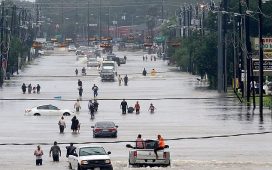Scientists say they have uncovered yet more evidence that suggests hunting may have helped humans become long-distance runners millions of years ago.
New research shows endurance pursuits for prey was not as rare in hunter-gatherer societies as previously thought.
Anthropologists said they found literature dating back to the early 1500s that suggest slow-paced, long-distance running was seen as an efficient way to capture animals such as wildebeest, deer, antelope and bison for food.
The team said its findings, published in the journal Nature Human Behaviour, challenge the view that lengthy hunting pursuits would have been physically costly because of the toll it takes on the human body.
Eugene Morin, a professor in the department of anthropology at Trent University in Canada, said this belief stems from a “cultural bias” amongst Westerners who tend to see running “as arduous, costly, and challenging”.
He told the PA news agency: “Westerners, being more sedentary, are generally not as fit as the Natives (indigenous people who descended from the earliest inhabitants of a country), and for this reason, probably consider endurance running as more challenging than people who run frequently.”
The findings also suggest snowy or harsh winter conditions would not put off human ancestors from endurance pursuits and may have been as efficient as other methods of catching prey such as chance encounter, snaring or ambushing, the researchers said.
Documented observations from 272 locations around the world show endurance pursuits would have been a commonly-used strategy, particularly when competing with other predators, the researchers said.
Westerners, being more sedentary… probably consider endurance running as more challenging than people who run frequently
Prof Eugene Morin
Prof Morin said: “We were able to show that running, or a mix of running and walking, can be efficient, and it was a global practice by foragers prior to the modern era.
“Endurance pursuits would have provided hominins (humans as well as extinct ancestors and close relatives of humans) with an evolutionary advantage while competing with carnivores for game.”
For the study, Prof Morin and his colleague Bruce Winterhalder, professor of anthropology and ecology at the University of California, Davis, reviewed nearly 400 cases looking at the potential role of hunting by endurance running.
It included first-hand accounts from different nomadic groups such as the Evenki people in Siberia, the Innu in Canada, the Apache in the US, the Mbuti in the Democratic Republic of Congo, the Pitjantjatjara in Australia, the Innuit in Alaska, and many more.
Documents show some running pursuits were greater than 100km.
Prof Morin told PA: “We were struck by the number of cases we were finding and by their wide range of ecological contexts, with examples including the Canadian tundra and the mountains of Hawaii.
“The few instances known to us before this work occurred in open, hot and typically arid plains.
“We have been impressed with evidence we found for those environments, but also by the many instances where these pursuits occurred in forest and snow-covered habitats outside of the tropics.
Unlike other mammals, including other primates such as chimpanzees, humans can sweat profusely and have lower limb muscles evolved for stamina rather than power
Prof Eugene Morin
“This opens the possibility of endurance pursuits by hominins in Europe and northern Asia, and in winter conditions.”
Prof Morin said the findings support a theory known as endurance running hypothesis, which proposes humans evolved to run long distances to hunt for prey around two million years ago.
He said: “Unlike other mammals, including other primates such as chimpanzees, humans can sweat profusely and have lower limb muscles evolved for stamina rather than power.
“It suggests that this hunting tactic has considerable antiquity.”
Prof Morin said the practice largely disappeared with the introduction of rifles and the widespread use of horses as well as hunting dogs.
Colonial disruptions of traditional societies may have also contributed to the decline of endurance pursuits, he added.











